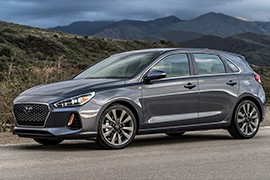HYUNDAI Elantra GT Models/Series Timeline, Specifications & Photos
First production year: 2012
Engines: Gasoline
Body style: Hatchback
With the first generation of Elantra GT released in 2012, 5 years after, Hyundai redesigns it and reveals the 2nd generation.
The Elantra GT was a smart hatchback that offered more cargo space than a small sedan. So instead of going for a crossover, the choice of getting the Elantra GT would have been quite as good.
The Elantra GT was powered by a 2.0-liter 4-cylinder engine that produced 173 hp, mated with a 6-speed manual transmission. The automatic transmission was optional and at an extra cost of around $1,000.
The small 4-door hatchback was available in a single trim level that could be improved with the two available extra packages.
The standard features included were 16-inch steel wheels, heated mirrors, air conditioning, cruise control, a cooled glovebox, Bluetooth connectivity and a 6-speaker sounds system. Overall, the standard version offered great features that could be enough for the daily driving.
One of the available packages was the Value Edition designed to add more luxury overall feel. The package included 17-inch alloys, a tweaked suspension, automatic headlights, foglight, keyless ignition and entry, along with leather upholstery and heated front seats.
The Tech package included a 7-inch screen, a rearview camera, a panoramic sunroof, ventilated from seats, integrated Android Auto and Apple CarPlat, as well as dual-zone automatic climate control and a navigation system.
Hyundai chose to name its European version of the i30 as the Elantra GT for the U.S. market. In 2015, the Korean carmaker introduced an updated version at the Chicago Auto Show.
Hyundai unveiled the second generation of the i30 at the 2011 Frankfurt Motor Show. In the following year, at the Chicago Auto Show, the Korean carmaker showed the U.S. version named Elantra GT. It was a strategic policy since the Elantra was already an established nameplate on American soil. After three years, the Korean carmaker introduced the facelifted version for its compact hatchback in the same location.
The new version featured a big, tall grille at the front, mostly found on bigger cars. Even though the headlights from the facelifted model looked very similar to those found on the 2012 model, they were not the same. Also, the fog-lights were completely different. The vehicles were virtually the same in the rear, except that the facelifted version was available with LED taillights.
Inside, Hyundai improved the cabin with new materials and a new infotainment unit. The instrument cluster featured a new TFT display instead of the older, LCD-based one. The Korean carmaker installed a new feature named Driver Selectable Steering mode for the steering wheel, and it offered three settings: Comfort, Normal, and Sport. While the first was good for parking maneuvers, the latter offered a stiffened response, good for spirited driving conditions.
Under the hood, Hyundai offered one engine choice mated as standard to a 6-speed manual, while a 6-speed automatic was on the options list.
In 2012, at the Chicago Auto Show, Hyundai introduced the 2013 model of the Elantra GT. It was inspired by the European five-door version and brought the functionality and the driving dynamics.
The 2012 Elantra GT was based on the Hyundai-Kia j4 platform, which was used in Europe for the i30 model range. It only shared the “Elantra” name with its sedan or coupe sibling and more parts with the European model.
On the outside, there was a different grille than on the Elantra, with a bigger, chromed rim around it. The fog-lights were incorporated on the outer side of the front spoiler in air-intakes-like black parts. Unlike the Elantra, the GT version featured flared front wheel arches, visually extended toward the back of the car in an ascending, sculptured, line on the side.
Inside, the dashboard followed the same design language as the Elantra, but with a different layout. A binocular-style instrument cluster and a re-shaped stack were definitely different than ton the compact sedan version. The rear seats were folding and could expand the trunk space up to 1444 liters (51 cu-ft).
For the powertrain, the Elantra GT was offered with a 1.8-liter engine, good enough to offer 148 hp. It was mated to a standard 6-speed manual or a 6-speed automatic with manual override control.


